Open Access, Peer-reviewed
eISSN 2093-9752

Open Access, Peer-reviewed
eISSN 2093-9752
Mi-Sun Kim
Ki-Kwang Lee
Kwantae Kim
http://dx.doi.org/10.5103/KJSB.2020.30.3.235 Epub 2020 October 13
Abstract
Objective: The purpose of this study was to investigate the differences between visual search, eye fixation positions, and eye fixation position on whole body regions while judging final matches of dance sports.
Method: Ten experienced judges (male 6, female 4) and six dance sports couples belonging to the top Korean leagues in the Korea Dance sports Federation were participated. Wearable eye trackers were used for data collection. The independent t-test was conducted to examine the effects of gender, and the two-way ANOVA was conducted to examine the effects of judges' gender, dance event, and ranking.
Results: It was found that the movement of male contestants was preferred, and the gaze fixation was high for torso movements in the judges' evaluations. Moreover, attention was focused on the upper body rather than the lower body; this was maintained for about seven seconds to evaluate each couple.
Conclusion: This find was the relative comparison between the two couples was the determining factor in winning or losing.
Keywords
Skating system Decision making Visual search strategy Behavioral analysis Dance sport
The judge's subjective judgment has a big influence on the outcome in sporting events (Han, Park & Ryu, 2012). Thus, giving optimal judgment requires a variety of skills such as observation and decision making (Anshel, 1995; Jung, 2011; Mascarenhas, Collins & Mortimer, 2002), and must have been based on specific training (Mascarenhas, Collins, Mortimer & Morris, 2005). However, the current judge seems to rely on their own experience rather than structured training (Mascarenhas et al., 2005). It is difficult to say that long experiences have been judged with objectivity, and simple experiences do not lead to expertise (Williams & Davids, 1995). Therefore, the judge's accurate judgment and decision-making ability are important for improving the objectivity of winning and losing.
Decision making is the ability to perceive various situations during a sporting event, extract and process appropriate clues, and ignore inappropriate clues (Kim, 2009). Through visual per- ception, we receive information about the other's posture, body direction, sports events (Wiliams, 2000; Rose & Christina, 1997), and obtains more than 80% of the visual information (Berger, 1989; Blakemore & Jennett, 2001). To minimize the time lags associated with making informed decisions and forecasts, there is a growing interest in identifying visual cues and strategies for professionals (Cauraugh & Janelle, 2004).
Visual search, which is a method of investigating the process of acquiring and using a lot of visual information, consists of making decisions based on visual information of the eye that moves continuously to focus on important information (Williams, Davids, Burwitz & Williams, 1993). However, in a rapid progress sport situation, all the information cannot be recognized and processed, so some of them are selected and processed (Park, 2009; Park, Ji & Park, 2014). Thus, the decision of the judge depends on what information was chosen.
In the early stages of research related to visual search, hard- ware approaches such as static and dynamic vision, depth per- ception and ambient vision were carried out, and after 1980, researches on software approaches such as the difference be- tween proper information acquisition process and accurate decision-making process were conducted (Abernethy, 1993). In addition, there were the studies according to proficiency in various sports events (Vickers, 1996; Park, 2005; Martell & Vickers, 2004; Park & Kim, 2004; Naito, Kato & Fukuda, 2004; Vaeyens, Lenoir, Williams, Mazyn & Philippaerts, 2007; Song & Han, 2018; Lee & Kim, 2012; Kim & Kim, 2012). However, most of the research has been analyzed visual search patterns through reactions to images projected on screens in the labora- tory. This might be different from information acquisition in the actual sports situation. Furthermore, studies on the judges, who play an important role in winning and losing sports games, are insufficient (Ghasemi, Momeni, Jafarzadehpur, Rezaee & Taheri, 2011).
Dance sports is the event where judges obtain and evaluate information about couples who make different figures on the outside of the floor. At this time, the judges can calculate approximately 3.75 seconds in the heat (24 couples), 7.50 seconds in the semi-final (12 couples), and 15 seconds in the final (6 couples), by calculating each couple roughly until the end of 1 minute 30 seconds of music for each event. Like this, what factors can judges judges use in selecting and processing information for a large number of couples in a short time? Kim and Jeong (2008) reported that the most important elements for perceiving by judges were posture, rhythm, and partnership, the next was a musical expression. Radler (1998) reported applying a comprehensive assessment of posture, beat, body line and hold, and balance to judge education. Radler (1998) reported applying a comprehensive assessment of posture, beat, body line and hold, and balance to judge education. Hiller and Hiller (2000) suggested timing and musical expression, technique, quality of movement and swing, style, hold and posture, partnering floor craft, characterization, choreography, presentation. However, there are so many evaluation factors that it is very difficult to compare many players in a short time.
Chang (2007), Kim and Morris (2007) reported that in order to simplify the various alternatives in consumption, attributes were selected by comparison or by weighting specific attributes. A skating system is a way of evaluating players by comparing them with their opponents (Kim & Jeon, 2018). So far, the pre- vious research on the judgment of dance sports only presents problems through objectivity and evaluation suitability through questionnaires or examination results. However, the research on evaluating judges during actual matches is insufficient.
Therefore, the purpose of this study was to investigate the difference between the visual search, eye fixation position, and eye fixation position of the whole body area during judging the final match of the dance sports. It could be used as a basis for understanding what criteria judge has evaluated in the actual game situation. The hypothesis of the study was as follows; First, there would be a difference in preference for looking at male and female players in decision-making about dance sports game judge evaluation. Second, the visual search strategy according to the dance event would be different in the decision making for the evaluation of the judgment of dance sports competition. Third, there would be a pattern that is generally used to determine ranking in decision-making about dance sports game judge evaluation.
1. Participants
The present study was selected the judges who have been appointed as a judge of the Grand Slam and national com- petition from the Korea Dance Sports Federation (KDF) which has been officially affiliated with the International Olympic Committee (IOC) (Table 1). They have no visual injuries or damages within six months before the experiment, and visual acuity of 0.7 or more was confirmed without any problem in visual search. All participants got experiment information and signed a consent form.
For designing the paradigm for the experiment, six dance sports couples who belong to the top Korean leagues in KDF were selected to create a game-like environment.
|
Group |
N |
Age |
Career
(yrs.) |
|
|
Dancesport |
Judge |
|||
|
M |
6 |
40.00±7.90 |
15.17±3.71 |
8.17±7.28 |
|
F |
4 |
38.25±5.44 |
12.25±8.26 |
6.75±6.85 |
2. Equipments
The present study was used wearable eye-tracker (Tobii Pro Glasses 2, Tobii Technology Inc., Sweden) to identify visual search (Figure 1). The sampling rate was set to 50 Hz and the head- band was used to fix for freely moving the participant's head and prevent slipping.
In addition, in order to reproduce the same situation as the actual dance sports finals, the skating system scorecard was produced. The produced skating system scorecard is shown in Figure 2.
3. Procedure
Before the experiment, all judge participants were instructed briefly about the eye-tracking device and asked to proceed with the judge decision as in the actual game. Participants wore eye-tracking devices and calibrated to obtain x and y coordinates of eye movements, and then provided sufficient time for the experiment to reduce cognitive and discomfort. To make the situation like a real game, the six couples of Latin dance players did fully warm-up exercise. Based on dance sports regulations, the music was conducted at 50~52 bpm for samba, at 30~32 bpm for chachacha, at 25~27 bpm for rumba, at 60~62 bpm for paso doble, at 42~44 bpm for Jive. Players' back numbers were randomly selected and attached. After that, the judge participants signed the scorecard according to the skating system, and at the same time as the music began, the judges began to judge.

4. Data analysis
The analysis of the captured video data was exported to mp4 video file format using eye-tracker analysis software Tobii Pro studio (Tobii Technology Inc., Sweden) and analyzed manually frame by frame. Tobii I-VT filter (moving median, window size: 3, window length: 20 ms, velocity threshold: 30 deg/s) was used to filter raw data on eye movement. The filter provides consistent results regardless of the sampling frequency, has low data distortion, and handles reasonable levels of noise (Olsen, 2012). All data were processed using MS Excel software (Micro- soft Inc., USA).
In this experiment, the visual search variables (gaze fixation duration ratio, gaze fixation frequency, eye movement frequency, gaze fixation location of the whole body area) of the judge were analyzed for about one minute and thirty seconds from the beginning of music in each event.
The gaze fixation duration ratio (FR) was set only when the minimum basic value of gaze fixation was set to 60 ms or more (Komogortsev, Gobert, Jayarathna, Koh & Gowda, 2010; Salojärvi et al., 2005; Over, Hooge, Vlaskamp & Erkelens, 2007; Radach, Huestegge & Reilly, 2008) and stayed in the position for 60 ms or more.
The gaze fixation frequency (FF) was analyzed for the number of times the judge looked at each player for each dance event.

The eye movement frequency (EF) was analyzed by analyzing the total number of trial movements between each position viewed by each player during the judging.
The gaze fixation location of the whole body area was analyzed by a head, trunk, arm, leg, full-body, and the rest re- spectively. The rest means looking out of the player, such as the scorecard or the surrounding environment.
|
|
Male player |
Female player |
t |
p |
|
Fixation duration ratio (%) |
60.22±11.00 |
39.78±11.00 |
t=10.180 |
p<.05 |
|
Fixation frequency (times) |
83.52±32.90 |
56.30±25.49 |
t=5.066 |
p<.05 |
|
Eye movement frequency (times) |
57.07±31.31 |
40.55±18.48 |
t=3.519 |
p<.05 |
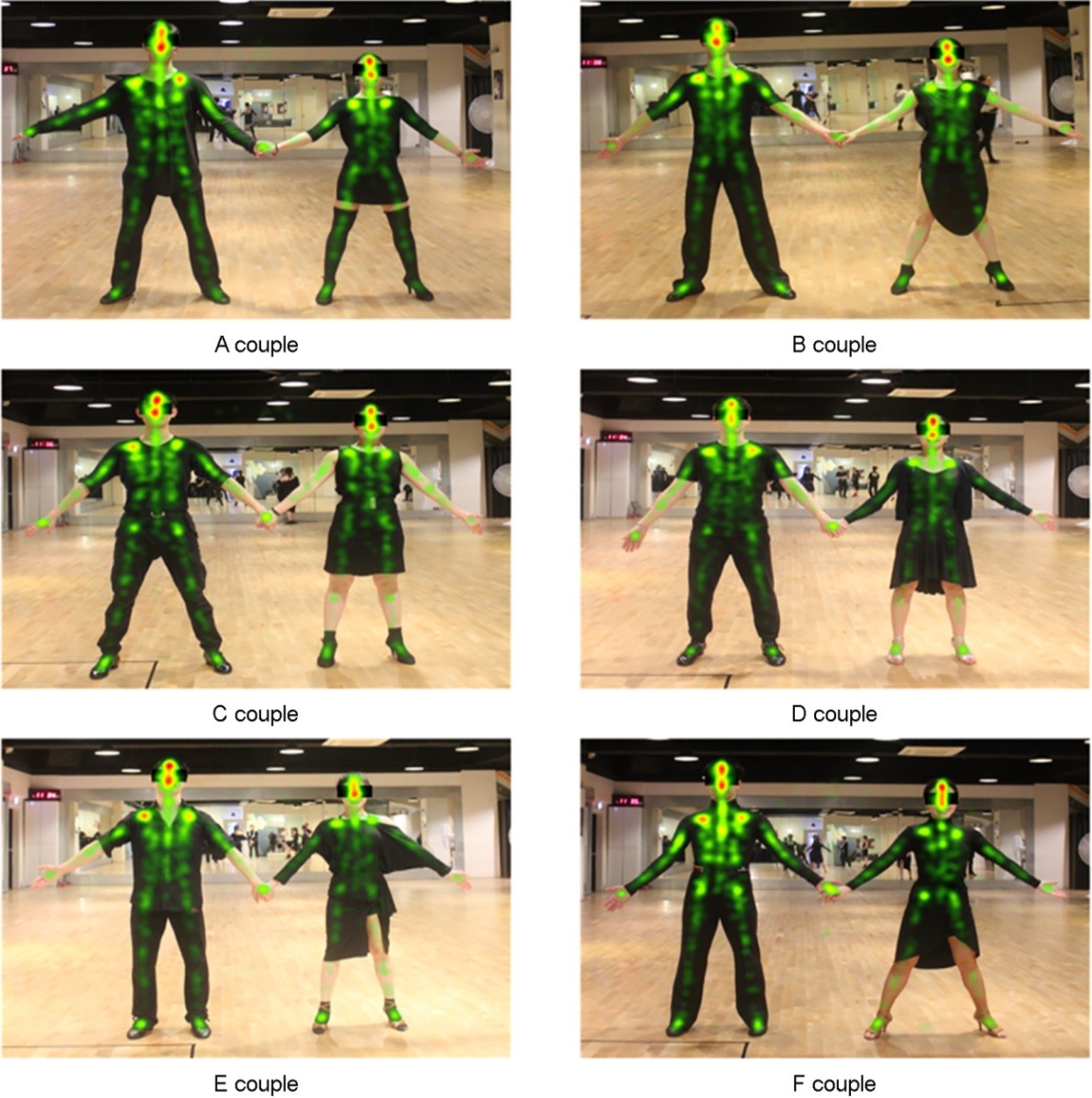
5. Statistical analysis
Statistical analysis was performed using SPSS version 25.0 (IBM, USA). An independent t-test was conducted to analyze according to gender. Two way ANOVA was conducted to analyze according to the gender of judges, dance event and ranking. The significance level was set at .05.
1. Preferences differences by players gender in deci- sions on evaluating the judges for the dance sports competition
There was a statistically significant difference in FR, FF, EF during judging a dance sports game for each male and female players (Table 2).
In addition, as a result of analyzing the eye fixation position by body region, it seems that the eye fixation was performed on the head and trunk a lot. In the trunk, high gaze fixation was observed on the shoulder area, and in the leg, the rate of fixation on the hip and foot was high. The male and female players showed similar shapes, and their eyes were fixed more on the upper body than on the lower body (Figure 3).
2. Differences by judges gender and dance events in decisions on evaluating the judges for the dance sports competition
The FR, FF, and EF analysis according to the judges gender and dance event did not show any significant difference in the dance sport competition. However, in the judgment gender, there were statistically significant differences in the leg, trunk, full body, and rest in FR (Figure 4). In FF, there were statistically significant differences in leg, full body, and rest (Figure 5). And in EF, only a statistically significant difference was found in the head (Figure 6).
Furthermore, as a result of analyzing the gaze fixing position for each body region in dance events, in the case of male judges, the upper body was examined in samba and paso doble events, and both upper and lower bodies were examined in chachacha, rumba, and jive events. In the case of female judges, both upper and lower bodies were examined in samba, chachacha, rumba, and jive events. And both male and female judges observed male players more than female players for judging in all events (Figure 7, Figure 8, Figure 9).

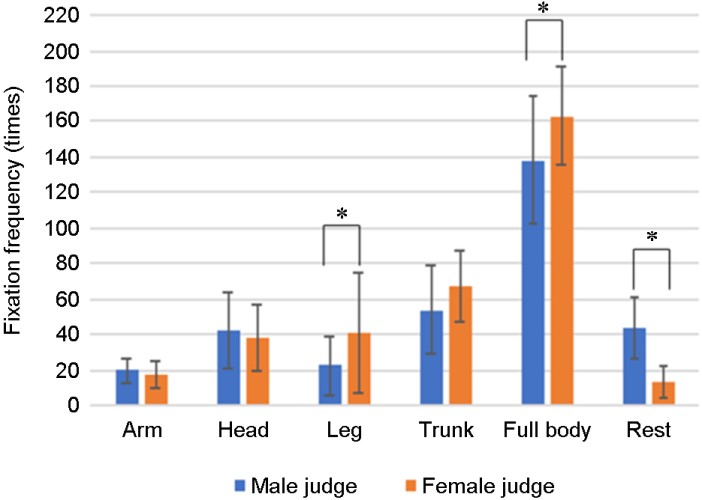
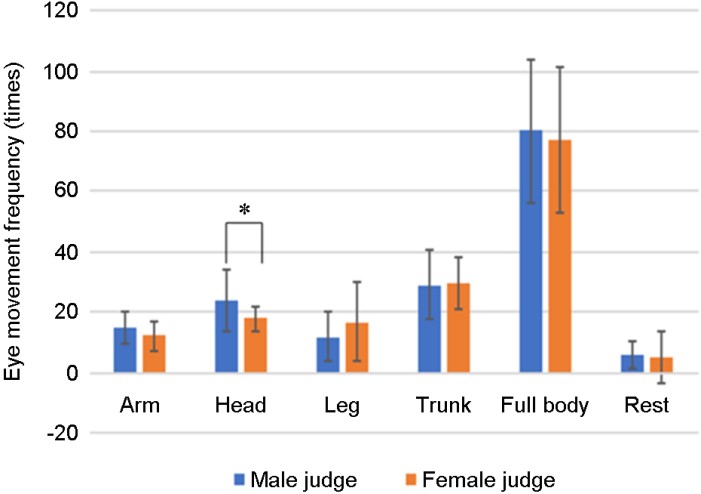
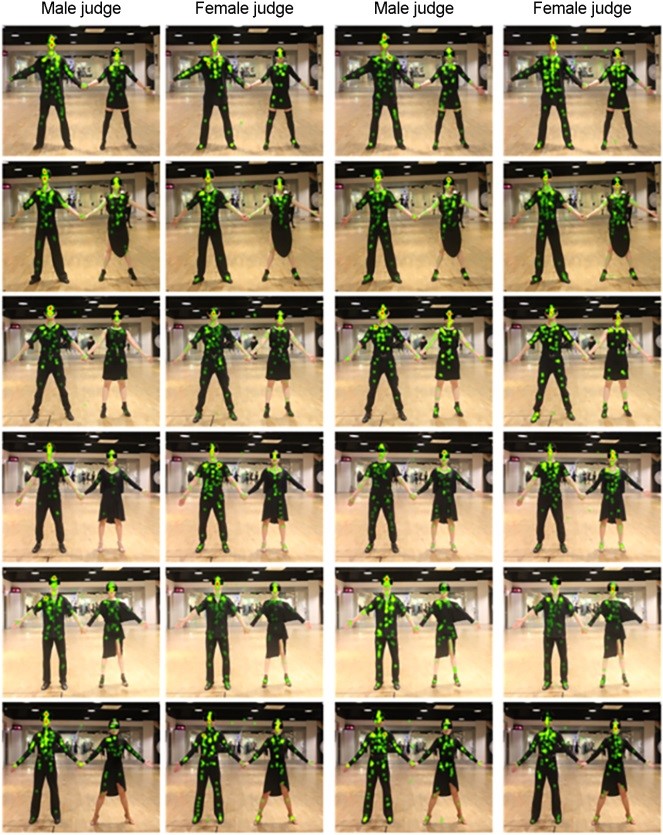

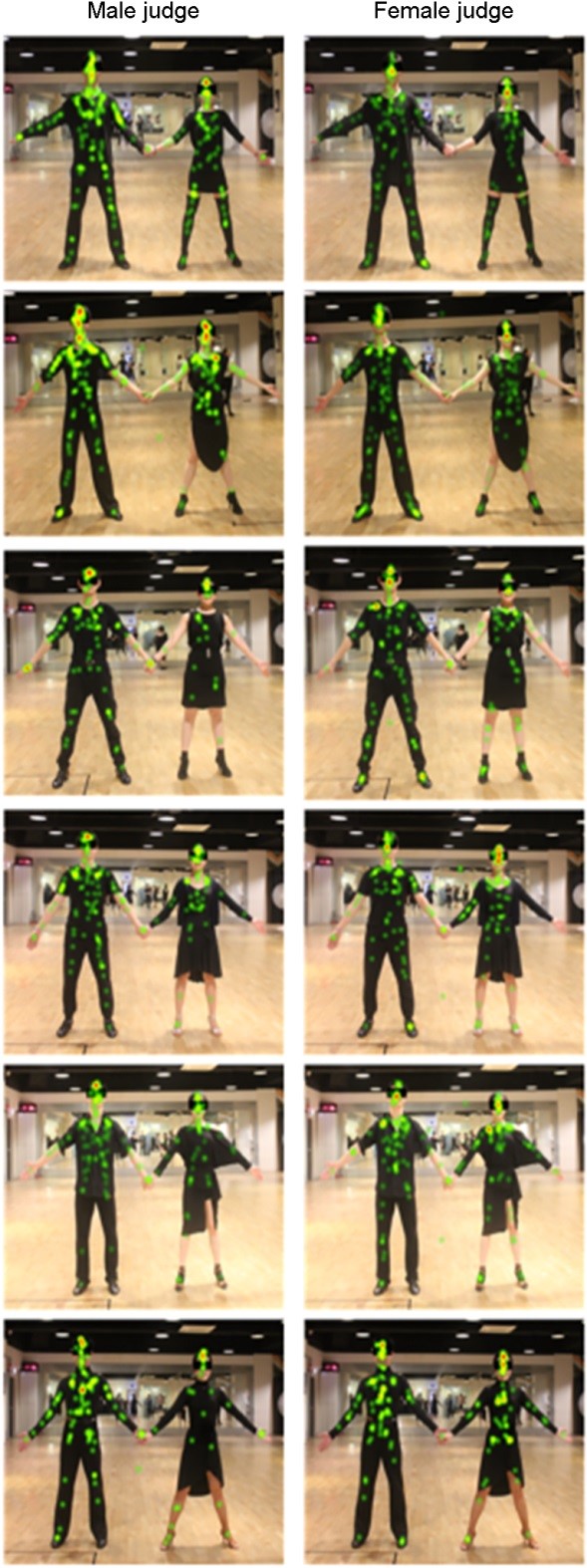
|
|
Rank |
Samba |
Chachacha |
Rumba |
Poso |
Jive |
Rank |
Event |
Rank
× Event |
|
Fixation (%) |
1 |
7.60±4.09 |
8.59±4.59 |
11.50±5.32 |
5.55±3.47 |
9.21±5.11 |
F=5.423 p<.05 |
F=.756 p=.555 |
F=1.278 p=.193 |
|
2 |
10.51±3.97 |
10.56±5.49 |
11.95±6.53 |
6.01±2.86 |
11.27±6.84 |
||||
|
3 |
10.37±3.63 |
13.46±5.28 |
9.27±5.08 |
10.46±6.91 |
8.12±6.82 |
||||
|
4 |
7.57±4.01 |
7.66±3.59 |
7.43±6.18 |
7.95±5.31 |
6.39±4.25 |
||||
|
5 |
8.82±2.02 |
9.26±4.42 |
7.81±5.44 |
9.86±6.52 |
7.21±3.90 |
||||
|
6 |
6.46±3.05 |
4.71±4.05 |
5.98±2.29 |
6.87±3.25 |
6.79±3.97 |
||||
|
Total |
8.55±3.71 |
9.04±5.17 |
8.99±5.54 |
7.78±5.12 |
8.16±5.34 |
||||
|
Fixation (times) |
1 |
22.00±9.59 |
27.00±13.35 |
31.00±11.25 |
13.50±5.95 |
29.70±19.26 |
F=5.014 p<.05 |
F=1.056 p=.379 |
F=1.698 p<.05 |
|
2 |
29.80±8.59 |
28.80±13.21 |
39.50±20.61 |
18.80±8.46 |
38.70±24.95 |
||||
|
3 |
28.50±9.29 |
38.90±10.61 |
24.60±14.74 |
26.70±14.05 |
23.70±21.84 |
||||
|
4 |
20.80±10.01 |
21.80±10.14 |
21.70±14.04 |
20.80±9.39 |
18.90±10.13 |
||||
|
5 |
25.70±7.92 |
22.00±10.60 |
22.50±14.26 |
31.40±27.72 |
21.30±11.43 |
||||
|
6 |
23.60±10.28 |
18.50±16.00 |
18.80±7.84 |
19.40±11.89 |
17.70±9.15 |
||||
|
Total |
25.07±9.50 |
26.17±13.70 |
26.35±15.40 |
21.77±15.25 |
25.00±18.06 |
||||
|
Eye (times) |
1 |
16.00±8.08 |
18.60±9.56 |
22.80±8.69 |
9.80±4.29 |
21.80±14.43 |
F=4.563 p<.05 |
F=1.570 p=.182 |
F=1.418 p=.113 |
|
2 |
18.90±5.13 |
21.70±12.15 |
26.40±13.87 |
13.60±4.88 |
27.70±16.26 |
||||
|
3 |
20.30±7.59 |
28.10±7.05 |
19.30±11.92 |
18.30±8.37 |
19.00±16.21 |
||||
|
4 |
15.00±8.33 |
14.00±4.35 |
15.60±9.02 |
15.40±7.35 |
14.30±7.99 |
||||
|
5 |
19.10±6.12 |
16.90±8.89 |
15.30±8.83 |
21.00±18.16 |
16.40±8.67 |
||||
|
6 |
17.10±8.62 |
13.50±10.98 |
14.90±6.98 |
13.20±7.81 |
13.80±6.63 |
||||
|
Total |
17.73±7.34 |
18.80±10.13 |
19.05±10.64 |
15.22±9.92 |
18.83±12.79 |
||||
|
|
|||||||||
3. Differences by ranking and dance events in deci- sions on evaluating the judges for the dance sports competition
FR did not show a statistically significant difference in main effects and interactions between couples and dance events during dance sports competition judging, but, in the case of FF, there was a statistical difference in interaction. In addition, although FR, FF, and EF did not show statistically significant differences according to dance event, however, there was a sta- tistically significant difference according to the ranking (Table 3).
Unlike other sports, dance sports are composed of several judges evaluating six or more players at once, so fast and efficient judging and management processes are important. Most of these screenings are determined by the judge's visual information (Song & Han, 2018). Therefore, the judge's visual search strategy is a very important factor in winning and losing the game.
Thus, this study investigated what strategy and information were obtained when deciding on the evaluation of the game judges during the competition evaluation of the dance sports finals.
Dance sports is a sport in which men and women perform cooperative movements together. In addition to technical factors, isolation and coordination, synchronization, and consistency of both players should all be evaluated. However, the result of the preference difference for each male and female player showed that the judge fixed the gaze of the male player about 1.5 times more than the female player, and moved 1.4 times more often to find the male player. This means that the judges prefer the movement of the male player to the evaluation of the dance sports competition rather than the movement of the female player. Dance sports consist of a male player 'lead' and a female player 'follow'. As can be seen from Lee (2004) who reported that the male player determines the direction and movement of the dance, dance sports can be deduced that the move- ments of male players have a greater impact on wins and losses. However, Myung, Kwak & Seong (2010) stated that judges should watch both men and women in detail during the game. The couples in the present study had a couple who had been training for two players together and a couple who did not. Moreover, each player's career and technical skills may be different. Therefore, further study is needed to determine how the ratio of training proficiency difference between male and female players affects win and loss.
The result of the position of eye fixation by body area for both male and female players showed that in the upper body, the eyes were fixed to the shoulder area, and the lower body was fixed to the hip and foot area for a long time. Furthermore, the result of the visual search strategy based on gender in- dicated that both the male and female judges had about 2.5 times higher FR, 2.2 times FF, and 1.9 times higher EF than other body areas. The high FR is related to the efficiency of the amount of information that can be obtained for a given time (Park et al., 2014). These results indicate that the trunk, the body part, is a very important factor during the evaluation of the judge. In dance sports, the most important factor to see and evaluate trunk movement is posture, line, hold, spin and turn, line and extended line, use of face, lead and follow. Moreover, the factors that can be evaluated by looking at the shoulder area are posture, body line, body shape, hold, how to hold, technique, quality of movement and swing (Kim & Jeong, 2008; Radler, 1998; Hiller & Hiller, 2000). In the case of hip and foot areas, posture, upper and lower body pendulum movement, quality of movement and swing, musical expression, beat, energy, balance and skill can be evaluated. The reason that the judges focused on the upper body rather than the lower body seems to be that the performance of the lower body was proven to be stable because the couples who par- ticipated in the present study belong to the high ranking in Korea. This is supported by Kim & Jeong (2008) report which is if the foot and leg movements and the upper and lower pendulum movements are performing well, then the upper body movements should be observed.
Meanwhile, many previous studies have reported that skilled people use strategy for making the decision that a longer time and lower frequency of gaze fixation (Park & Kim, 2004; Lee, 2010; Park, Hong & Noh, 2010; Vickers, 1992; Savelsbergh, Williams, Kamp & Ward, 2002; Vaeyens et al., 2007). In this study, however, female judges used a strategy with high FR and low FF, and male judges used a strategy with low FR and low FF. This means that, compared to the female judge, the male judge focused on information other than the players during the evaluation. This is different from study of Kim (2014), in which male judges focus their attention on external stimuli more effectively in judgment than female judges. In the case of male judges, the phenomenon of "saccadic suppression", which is less visually sensitive in obtaining visual information from fast-moving players, appears to have occurred. But from a different perspective, in the case of the male judge, it could be said that they used a context control strategy to obtain useful information around the environment with an ambient vision system while keeping the gaze on one visual cue. In general, the non-skilled person uses a target control strategy to make decisions based only on the information coming from the fovea with the focal vision system with the eye fixed on one visual cue and the skilled person appears to have used a structural control strategy (Han et al., 2012). Gur et al. (2000) reported that the areas of brain activation related to spatial perception were activated in the right hemisphere for women and in both the hemispheres for men. Through these previous studies, the judges may have to consider the possibility of using the micro or macro evaluation strategies in evaluating the players during dance sports. Microscopic means detailed observation of a small object, and macroscopic means trying to grasp the object from a holistic standpoint (Kim & Um, 2017).
In determining the first rank, the male judges ranked 59.90 ± 19.25s and the female judges 59.88 ± 18.29s. For 1 hour 30 minutes for each dance event, the male judges ranked 3.31 ± 1.89 and the female judges ranked 4.60 ± 1.78. And the rest were ranked after the music was over. The previous study has reported that the judge has about 25 seconds to evaluate a couple (Hur, 2006). However, in the present study, the average time for one judge to fix the evaluation per couple was 7.71 ± 4.58s, which was about 3~4 times shorter than the time suggested in the previous study. This suggests that one hour and thirty minutes is difficult to evaluate six players, and there is a possibility that other external factors may be involved in the evaluation due to psychological pressure in ranking after the music is over.
The judges were then able to determine the rankings and check the scorecards into three types: comprehensive checks after the end of the music, checks before the end of the music, and before and after the end of the music. In addition, the music of each dance event is started, and the movement of the gaze is much in about three measures (10 seconds), and then it can be seen that the couple observes each other by fixing the gaze one by one. In general, the judge tended to check the top rank first or the bottom rank first when determining the ranking and checking the scorecard.
What's interesting here is the observation of players to check before checking the scorecard, then observing the player to be checked and the player above and below the ranking, after that judge decided to check the ranking. When deciding and checking ranks, there were frequent cases of checking first and second place, second and third place, and fifth and sixth place. In FR, 3rd place in high rank and 5th place in low rank were checked for a long time. These results surmise that compare 1st and 2nd place to determine 1st place, compare 2nd and 3rd place to decide 2nd or 3rd place, compare 4th and 5th place to determine 4th place, and decide 5th or 6th by comparing 5th and 6th (Table 3). In addition, in the present study found the judges have three ranking process types; ascending order (e.g. first to sixth), descending order (e.g. 6th to 1st), and checking the middle rank after checking the top and bottom rank. This result supports Kim & Jeon (2018) opinion that relative com- parison results focus on how to do better than the opponent in the ranking process. However, in the present study, it was not known which evaluation factors were weighted for the comparison of the two couples and whether all judges were evaluated using the same weight for all athletes.
Dance sports Latin competitions proceed samba, chachacha, rumba, paso doble and jive in sequence. In the present study, there was no statistically significant difference in visual search strategy according to dance events during the decision making for judgment evaluation. However, if you look at Figure 10, you can see that the FR on the samba event, which is the first event in the judgment, is high. This can be inferred from the fact that the previous event samba influences the evaluation of the next event chachacha. In other words, it could be considered that the general motor ability, which is the player's ability to perform different motor skills is determined by one general ability, hypothesis was applied.
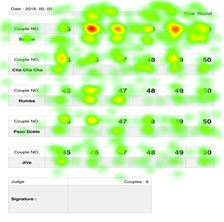
The study did not experiment by setting weights or specific factors separately because we thought we should look at several evaluation factors at the same time instead of one. Even though many previous studies experimented with questionnaires or interviews to analyze the results, the present study only the visual search strategy according to eye movement was used to analyze. Because we concerned the decision will be influenced by the time difference, rather than the decision at the moment of evaluation
In this study, it was confirmed that the judges use different visual search strategies according to players' gender, judges' gender, and ranking when judging the dance sports finals. In addition, it was found that the movement of male players was preferred, and the gaze fixation was high in the movement of the trunk in the judge evaluation. Moreover, attention was focused on the upper body rather than the lower body, and it was owned for about 7 seconds to evaluate each couple, and the relative comparison between the two couples was deter- mined to win or lose. Furthermore, it can be presumed to apply the general motor ability hypothesis to the judgment.
References
1. Abernethy, B. (1993). The nature of expertise in sport. In S. Serpa, J. Alves, V. Ferreira, & A. Paula-Brito (Eds.) Proceed- ings of the VIII th World Congress of Sport Psychology. Lisbon, Portugal: International Society of Sport Psychology, 18-22.
2. Anshel, M. H. (1995). Development of a rating scale for deter- mining competence in basketball referees: Implications for sport psychology. The Sport Psychologist, 9(1), 4-28.
Google Scholar
3. Berger, A. A. (1989). Seeing is Believing: An Introduction to Visual Communication. Mayfield Publishing Company, 1240 Villa Street, Mountain View, CA 94041.
Google Scholar
4. Blakemore, C. & Jennett, S. (2001) The oxford companion to the Body. New York: Oxford University Press. BMC Public Health.
Google Scholar
5. Cauraugh, J. H. & Janelle, C. M. (2004). Visual search and cue utilisation in racket sports. In Interceptive actions in sport (pp. 80-105). Routledge.
6. Chang, C. (2007). Diagnostic Advertising Content and Individual Differences: Testing a Resource-matching Perspective with a Taiwanese Sample. The Journal of Advertising, 36, 75-84.
Google Scholar
7. Ghasemi, A., Momeni, M., Jafarzadehpur, E., Rezaee, M. & Taheri, H. (2011). Visual skills involved in decision making by expert referees. Perceptual and Motor Skills, 112(1), 161-171.
Google Scholar
8. Gur, R. C., Alsop, D., Glahn, D., Petty, R., Swanson, C. L., Maldjian, J. A. ... & Gur, R. E. (2000). An fMRI study of sex differences in regional activation to a verbal and a spatial task. Brain and Language, 74(2), 157-170.
Google Scholar
9. Han, D. W., Park, D. J. & Ryu, D. H. (2012). Differences of visual search strategies and actual perceived eye-focus locations on expertise levels of basketball referee. Korean Journal of Sport Psychology, 23(4), 305-320.
10. Hiller, S. & Hiller, L. (2000). Judging. Dance News. newspaper, 16th, November.
11. Hur, K. A. (2006). An Analysis on Judges' Criteria for Judgment in Dance Sports Competition in Korea. Dept. of Physical Education, Kyungnam University, Korea, Gyeongsangnam-do.
12. Jung, H. (2011). A Study on Fairness of Referee Judgment on University Taekwondo Players. Journal of Korean Society for the Study of Physical Education, 16(1), 159-171.
13. Kim, C. L. & Kim, S. J. (2012). Visual search strategies and antici- pation ability between expert and novice taekwondo players. Korean Journal of Sport Psychology, 23(3), 61-70.
14. Kim, E. J. & Jeong, J. O. (2008). The Mixed Method for Devel- opment of Preliminary Dance Sport Judging Scale. The Korean Journal of Measurement and Evaluation in Physical Education and Sports Science, 10(1), 13-29.
15. Kim, E. S. (2014). Relationship among Attention, Preference and Concentration of Adjudicator Judgement for development New Judging System in Dance Sport Competition. Korean Journal of Sports Science, 23(6), 493-508.
Google Scholar
16. Kim, J. & Morris, J. D. (2007). The power of affective response and cognitive structure in product-trial attitude formation. Journal of Advertising, 36(1), 95-106.
Google Scholar
17. Kim, J. E. & Jeon, Y. J. (2018). Ranking Determination of Dance sport Players: Application of Rasch Rating Scale Model. Journal of the Korean Society of Dance, 36(4), 45-67.
18. Kim, M. J. & Um, G. J. (2017). A Study on the Macro/Micro Reading in Information Design. Journal of the Korean Society Design Culture, 23(4), 105-114.
19. Kim, S. J. (2009). Motor learning and control, Seoul: Daehan- media.
20. Komogortsev, O. V., Gobert, D. V., Jayarathna, S., Koh, D. H. & Gowda, S. M. (2010). Standardization of automated analyses of oculomotor fixation and saccadic behaviors. IEEE Trans- actions on Biomedical Engineering, 57(11), 2635-2645.
Google Scholar
21. Lee, Y. S. (2004). The lure of dance. Seoul: Yeoldaelim.
22. Lee, J, H. (2010). Visual Search Patterns and Reaction Move- ment in Taekwondo According to Expertise. Seoul National University, Korea, Seoul.
23. Lee, J. H. & Kim, S. J. (2012). Visual Search Patterns and Reaction Movement in Taekwondo According to Expertise. Korean Journal of Sport Science, 23(2), 274-284.
24. Martell, S. G. & Vickers, J. N. (2004). Gaze characteristics of elite and near-elite athletes in ice hockey defensive tactics. Human Movement Science, 22(6), 689-712.
Google Scholar
25. Mascarenhas, D. R., Collins, D. & Mortimer, P. (2002). The art of reason versus the exactness of science in elite refereeing: Comments on Plessner and Betsch (2001). Journal of Sport and Exercise Psychology, 24(3), 328-333.
26. Mascarenhas, D. R., Collins, D., Mortimer, P. W. & Morris, B. (2005). Training accurate and coherent decision making in rugby union referees. The Sport Psychologist, 19(2), 131 -147.
Google Scholar
27. Myung, J. M., Kwak, S. H. & Seong, C. H. (2010). Conceptual Structure of Partnership in Dance sport. The Korean Journal of Physical Education, 49(6), 573-580.
28. Naito, K., Kato, T. & Fukuda, T. (2004). Expertise and position of line of sight in golf putting. Perceptual and Motor Skills, 99(1), 163-170.
Google Scholar
29. Olsen, A. (2012). The Tobii I-VT fixation filter. Tobii Technology.
Google Scholar
30. Over, E. A. B., Hooge, I. T. C., Vlaskamp, B. N. S. & Erkelens, C. J. (2007). Coarse-to-fine eye movement strategy in visual search. Vision Research, 47(17), 2272-2280.
Google Scholar
31. Park, S. H. (2005). The Change of Gaze Behavior, Eye-Head Coordination, and Temporal Characteristics of Swing by Task Constraints in Tennis Volley Strokes. International Journal of Applied Sports Sciences, 17(1).
Google Scholar
32. Park, S. H. (2009). Acquisition process and measurement method of Visual information. Sports Science, 47-54.
33. Park, S. H. & Kim, S. J. (2004). Visual search strategy of defen- sive players in volleyball. The Korean Journal of Physical Education, 43(6), 227-236.
34. Park, I. K., Ji, J. H. & Park, S. H. (2014). Differences in Visual Search and Decision-Making across Expertise Levels of Rugby Referee. Korean Journal of Sport Psychology, 25(1), 13-27.
35. Park, I. J., Hong, J. H. & Noh, S. Y. (2010). The Analysis for Factor of Attention and Visual Search in Expertise and Distance of Golf Putting. Korean Society of Sport Psychology, 21(3), 49-70.
36. Radach, R., Huestegge, L. & Reilly, R. (2008). The role of global top-down factors in local eye-movement control in reading. Psychological Research, 72(6), 675-688.
Google Scholar
37. Radler, D. (1998). How A Dance Competition Is Judged?. Re- trieved from http://user.aol.com/ballroomds/judge.html.
38. Rose, D. J. & Christina, R. W. (1997). A multilevel approach to the study of motor control and learning. Boston: Allyn and Bacon.
39. Salojärvi, J., Puolamäki, K., Simola, J., Kovanen, L., Kojo, I. & Kaski, S. (2005). Inferring relevance from eye movements: Feature extraction. In Workshop at NIPS 2005, in Whistler, BC, Canada, on December 10, 2005. (p. 45).
Google Scholar
40. Savelsbergh, G. J., Williams, A. M., Kamp, J. V. D. & Ward, P. (2002). Visual search, anticipation and expertise in soccer goalkeepers. Journal of Sports Sciences, 20(3), 279-287.
Google Scholar
41. Song, S. H. & Han, D. W. (2018). Bowling Expertise and Visual Search. Korean Journal of Sport Psychology, 29(1), 69-78.
42. Vaeyens, R., Lenoir, M., Williams, A. M., Mazyn, L. & Philippaerts, R. M. (2007). The effects of task constraints on visual search behavior and decision-making skill in youth soccer players. Journal of Sport and Exercise Psychology, 29(2), 147-169.
Google Scholar
43. Vickers, J. N. (1992). Gaze control in putting. Perception, 21(1), 117-132.
Google Scholar
44. Vickers, J. N. (1996). Visual control when aiming at a far target. Journal of Experimental Psychology: Human Perception and Performance, 22(2), 342.
Google Scholar
45. Williams, A. M. (2000). Perceptual skill in soccer: Implications for talent identification and development. Journal of Sports Sciences, 18(9), 737-750.
Google Scholar
46. Williams, M. & Davids, K. (1995). Declarative knowledge in sport: A by-product of experience or a characteristic of expertise?. Journal of Sport and Exercise Psychology, 17(3), 259-275.
Google Scholar
47. Williams, A. M., Davids, K., Burwitz, L. & Williams, J. G. (1993). Visual search and sports performance. Australian Journal of Science and Medicine in Sport, 25(2), 55-65.
Google Scholar